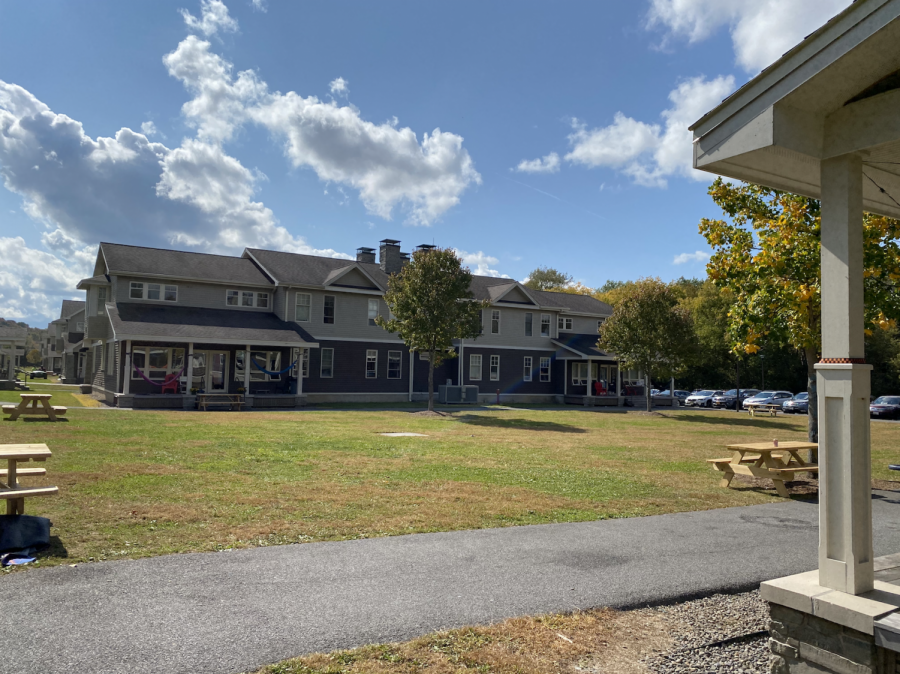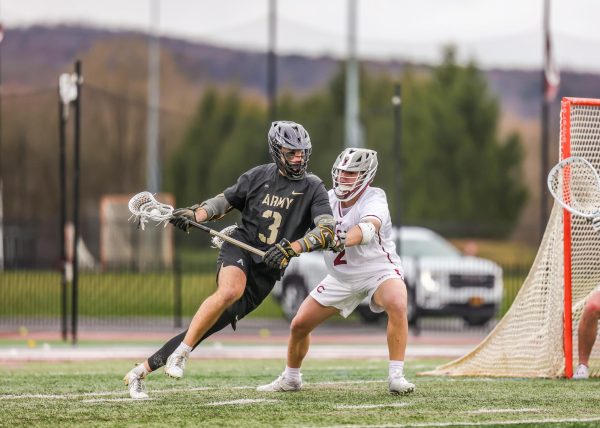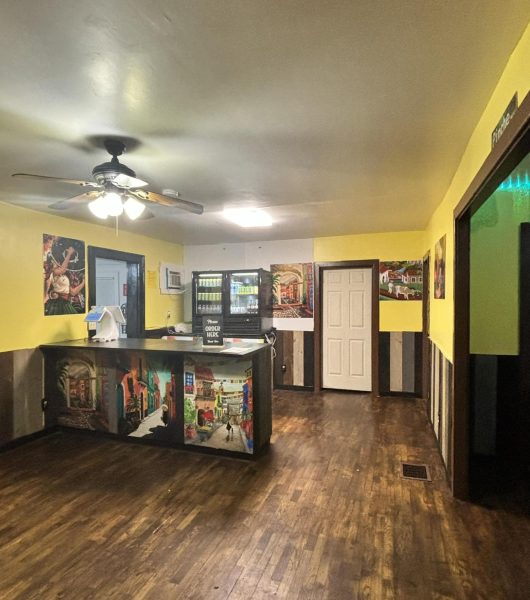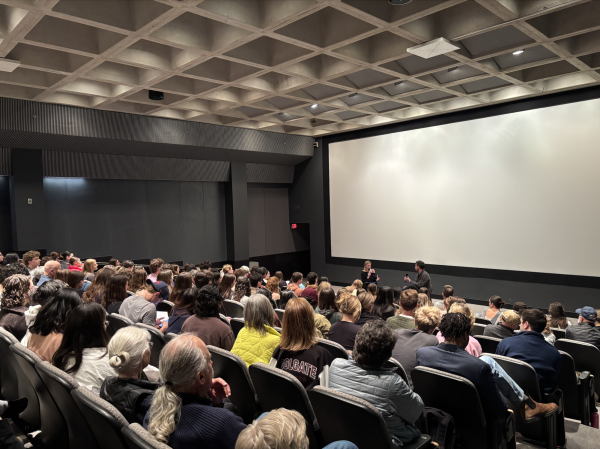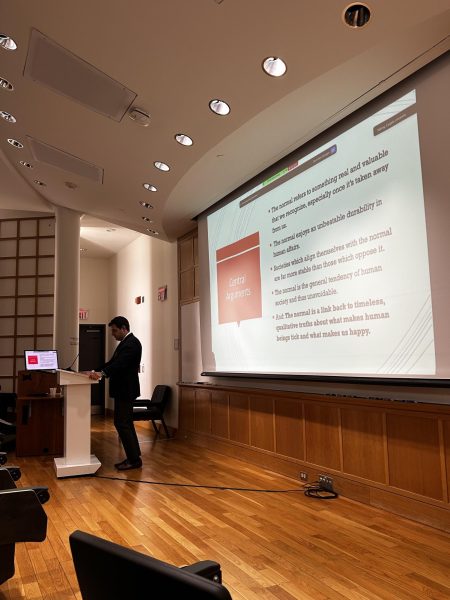Mixed University Messaging Over Behavior at the Townhouses Raises Concerns
Reports of rule-breaking behavior at the townhouses have raised consistent concern from students and administration throughout the semester. While Commitment to Community Health Violations had decreased since a University-hosted town hall with the townhouses early last month, a reported gathering and confusing response from President Brian Casey this weekend has raised new concerns of inappropriate behavior and mixed messaging.
In his Sept. 26 video message accompanying the Colgate Together Digest, Casey mentioned a reported gathering at the townhouses the night before. Residents subsequently reported the gathering included the inhabitants of two townhouses and initially around 20 additional students from different residences. The gathering was reported as taking place between multiple porches and on a townhouse quad. Based on Casey’s message and reports from townhouse residents, the gathering did not appear to strictly adhere to the Commitment to Community Health guidelines and Campus Safety and the Dean of College Division have opened an investigation into the gathering.
According to Casey, Campus Safety responded to the event three times. Casey arrived at the townhouses between the second and third Campus Safety visit, at which point around 35 students were congregated on the townhouse quad. Casey said his visit was not in response to the gathering, and that he was unaware of the gathering during his time at the townhouses. Rather, the visit was one of his routine weekend trips around campus with Senior Vice President for Finance and Administration JS Hope to “bolster the spirit of students… and to discourage gatherings that would violate our campus’ Commitment.” Casey explained in his video that these visits are meant to relieve pressure from Campus Safety by dispersing unsafe gatherings, get a pulse on night activity around campus and make personal appeals to students to follow the Commitment to Community Health.
“My presence at the townhouses was not part of any formal response to a gathering that had failed to disperse. I was unaware at the time of our brief visit there that this is what had happened,” Casey said. “It was just one of the places we stopped by as Vice President Hope and I were taking a look at activity around the campus, and trying to steer students in a good direction.”
When Casey’s video surfaced Saturday morning claiming he had “stopped at the townhouses to reinforce that a gathering there was too large,” many residents of the townhouses reported feeling blindsided. The video implies that Casey and Campus Safety had attempted to scatter the gathering and students nonetheless returned, and that the tone of Casey’s visit was disciplinary.
However, residents explained that neither Casey nor Campus Safety had made clear they were in violation of the Commitment to Community Health, and instead told students multiple times that the only concern was a noise complaint. Junior and townhouse resident Matt Martinez Sutton said that Casey affirmed that residents were acting safely during his visit and even entered a townhouse, which is against the rules outlined in Gate 1.
Further, Martinez Sutton said Casey’s presence exacerbated the gathering, rather than diminishing it, as about 15-20 additional residents came out of their houses to see Casey. Martinez Sutton said Casey also told them to turn the music back on when it had stopped, and that after Casey left, students didn’t feel the need to disperse because their behavior had, in their eyes, been affirmed.
Casey said he is upset that his cheerful attitude was misread by some as condoning unsafe behavior.
“So many people have — I have — communicated repeatedly and at length about the need for the community’s commitment to public health. It is deeply unfortunate if my presence — and even cheerfulness — could lead some students to assume that the rules had then simply been set aside for the evening, despite my efforts to encourage students to be mindful of them,” Casey said. “…I do think you can be warm and kind and speak about the need to follow community guidelines. I try to do that every day, and with every student I see.”
Junior townhouse resident Owen Hallinan said even though there was inappropriate activity going on at the Townhouses, Casey’s presence only served to complicate the matter.
“From my perspective, it looked like a gathering that did not adhere to the Gate 1 restrictions,” Hallinan said. “But with that said, Casey’s presence was not seen as serving to shut anything down; it was received as more of a celebrity appearance than anything else.”
Hallinan said he can understand why students were confused by the tone of the video message given Casey’s behavior, as it exhibited a stark contrast from Casey’s demeanor the night prior.
“He didn’t ‘bust’ anything, but he should have based on his feelings that he expressed the next day. The tohos are being treated as they should be by campo [because] it’s a dangerous area in terms of the virus due to the high number of close contacts,” Hallinan said. “The problem I saw was [Casey] acting like everything was fine when it apparently wasn’t… He can’t have it both ways,” Hallinan said.
Photos and videos circulated of Casey’s visit both inside and outside of a townhouse. Hallinan and others were frustrated Casey had entered a Townhouse. Casey addressed these photos in his video correspondence, saying that he understands they may have wrongly read as support for the unsafe gathering.
“I think those photos might capture my attempt to be supportive of students, but obviously do not capture any efforts that I made to encourage those same students to make smart choices. It is deeply unfortunate (quite maddening, actually) to see this partial representation of a short stop at the townhouses — social media rarely can offer context,” Casey said.
Students were further confused by what appeared to be an ice cream truck sent specifically to the townhouses by the Office of the President as a token of gratitude for good behavior, seemingly a followup to Casey’s visit the night before. Casey said the ice cream was rather sent around to the entire campus as a “general gesture of support for all students.”
Even so, Casey sees little room for confusion, and says he will treat every student breaking the rules the same.
“Students who gather in large groups without masks should not be surprised when there is an administrative response,” Casey said.
Casey was saddened that an honest effort to connect with students was soured.
“Being with and among students is a perpetual source of energy and joy for me… And to have that seem confusing or harmful in this situation, or any situation, has been a very, very painful thing for me to consider,” Casey said. “I do have to say that I deeply regret that my presence that night anywhere on the campus would seem to undercut the enormous efforts undertaken by so many to make this semester as successful as it has been… If that is the case I simply must acknowledge that and apologize for that.”
This is not the first time the townhouses have raised concerns, and residents have often felt there is a disconnect between University messaging and townhouse behavior.
Vice President and Dean of the College Paul McLoughlin, Associate Vice President for Campus Safety Dan Gough and other administrators hosted the aforementioned town hall meeting with townhouse residents on Sept. 2 following increasing reports of Community Health Violations. Director of Residential Life Stacey Millard said that 25% of all Community Health Violations submitted at the time of the town hall were from the townhouses. This, in addition to mask, social distancing and quarantine violations reported to Campus Safety and seen by monitors during outside time, were what prompted the town hall.
“The goal for the meeting was to inspire a partnership and renew the shared commitment to the expectations of Gate 0 and other guidelines,” Millard said.
Since the town hall, Millard explained, the number of violations and reports of inappropriate behavior have decreased. Even so, Martinez Sutton said the town hall meeting was unproductive, and that student voices were not heard. Junior townhouse resident William* said that he thinks the town hall was helpful for common understanding among residents, but agreed student voices weren’t heard and nothing has changed.
William still feels uncomfortable with student behavior at the townhouses. He reported that on any given night, residents of the townhouses will decide to socialize in communal outdoor areas, and that up to 30 students from different townhouses and residences across campus will gather on a quad to drink and hang out. William explained that as inhibition lowers, behavior begins to worsen.
“Everyone brings a mask but they don’t necessarily wear it the whole time because they’re drinking and they justify it that way. They also justify it with ‘Well if I can get a meal with these people, why can’t I drink with these people like this,’ but the unfortunate thing is, as you drink, your judgement kind of goes, and then you see people on porches that they shouldn’t be on. It’s messy,” William said.
Junior Juliette,* who does not live at the townhouses but has witnessed unsafe gatherings there, believes the townhouses are acting far less safely than other residences around campus. Juliette reports witnessing gatherings that are too large and make no effort to maintain distance between non-family units or wear masks.
“My perception of the townhouses, [given that] I don’t live there and I don’t see it 100% of the time, is definitely that people are not taking the urgency of the situation as seriously as they are in other places,” Juliette said. “I think it’s a pretty large display of privilege to think that you’re above the rules and that you can gather in the way that I’ve seen.”
Martinez Sutton said that while he acknowledges there has been rule breaking at the townhouses, the problem he sees is in the culture of self-monitoring and disproportionate attention paid to the townhouses by Campus Safety, as he is also confident rules are being broken in other living spaces as well. Both Martinez Sutton and William believe there is not necessarily more rule-breaking occurring at the townhouses, but rather external factors that contribute to this perception.
“There’s more that goes into someone deciding to call Campus Safety on someone… than simply whether or not that person is breaking the rules. There’s more that goes into it a lot of the time, and I would say there’s no way [social dynamics and heightened monitoring] can’t have something to do with the volume of reports,” Martinez Sutton said.
William and Martinez Sutton explained that what has developed at the townhouses is a stress-inducing system of self and University monitoring, which William reports generates the feeling of constantly being watched. All throughout the day, students are taking photos of other townhouses, filing reports, discussing rumors and creating a contentious environment.
“[All the townhouses are] in a U-shape, so it’s basically an open arena to watch people… We definitely have seen photos going around between different friend groups of different houses breaking rules, but not necessarily always submitting them. It’s more of a weird, ‘I know what you did, stop doing it or else’ [threat],” William said. “…It definitely results in a lot of paranoia.”
Both Martinez Sutton and William have noticed that reporting tends to be influenced by the social culture between houses and friend groups, and attribute a large amount of the reports to this culture and resulting undue attention from Campus Safety.
Hallinan said he supports the increased Campus Safety monitoring given the risk inherent to the townhouses.
“I agree that the townhouses should be monitored heavily but due to potential, not precedent. That many people coming in close contact with each other means the townhouses could potentially be the site of a large infection zone, but the actions I have observed of the residents have been responsible,” Hallinan said.
Martinez Sutton takes issue with University messaging that fails to recognize the unique struggles that are inherent in the townhouse set-up, and instead falsely implies that students have been set up to succeed. Martinez Sutton believes the University didn’t take accountability for concerns raised by students and instead used the townhouses as a scapegoat, reinforcing the narrative that students alone are jeopardizing the plan’s success.
“It’s very clear… they’re afraid of a subculture which normalizes the breaking of rules developing [at the townhouses]… And I understand how that can be concerning. My problem was not with their concerns, or the legitimacy of their concerns, it was the way they interacted with us and the way they showed continuous disrespect for us… It was infuriating,” Martinez Sutton said.
Juliette believes this subculture may already exist and that certain rule-breaking behaviors have been normalized at the townhouses, accounting for some of the disconnect between townhouse residents and campus perception of behavior.
“I think the townhouses may be in their own little bubble, where certain behaviors are a little bit more normalized there than they would be on the rest of campus,” Juliette said. “I don’t know if the townhouses are necessarily so much worse than other places, but I don’t think the fact that they’re not exorbitantly worse, or they’re not an anomaly makes what’s going on okay… Aren’t we all supposed to follow the rules because this is life and death? Because 200,000 people in our country have died because of COVID?”
*All identifying details have been changed to preserve source anonymity.
Emily Rahhal is a senior from Los Angeles, California double concentrating in Middle Eastern and Islamic Studies and Religion. She has previously worked...


